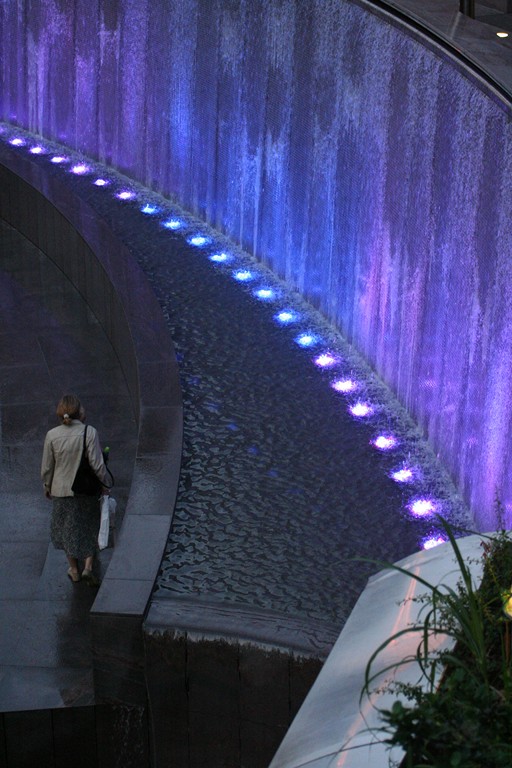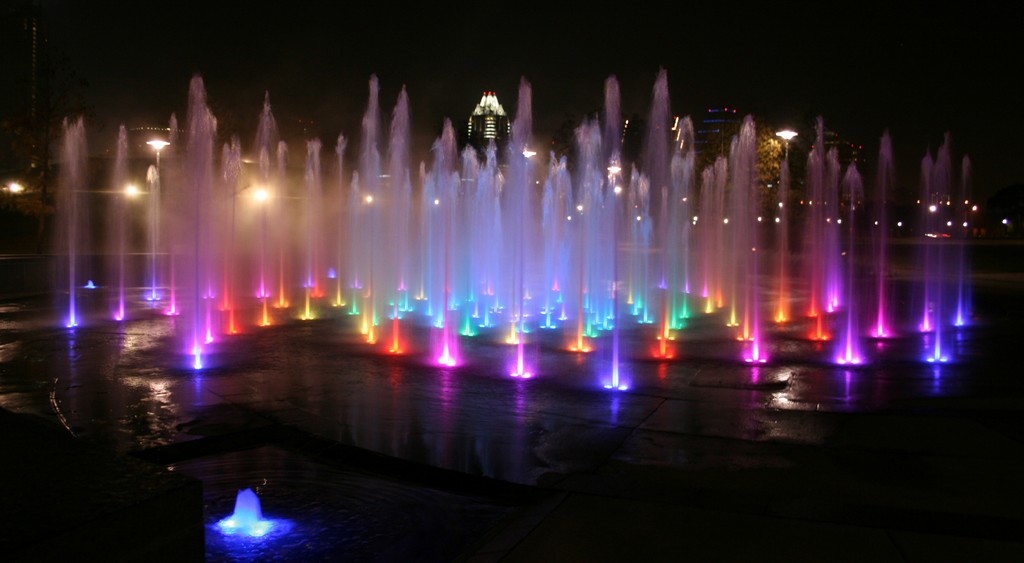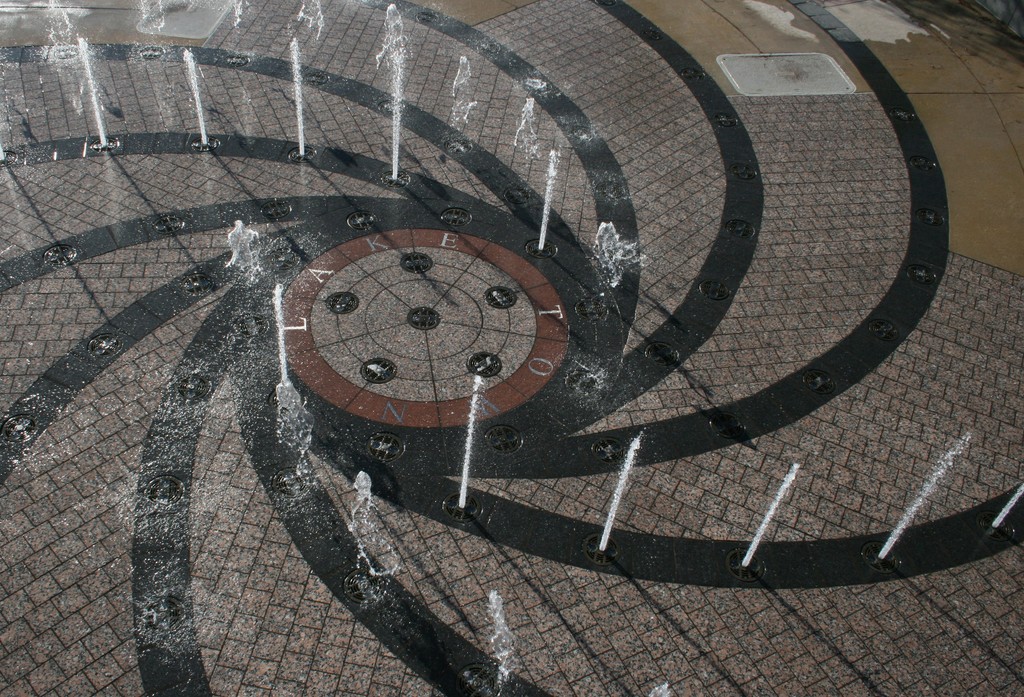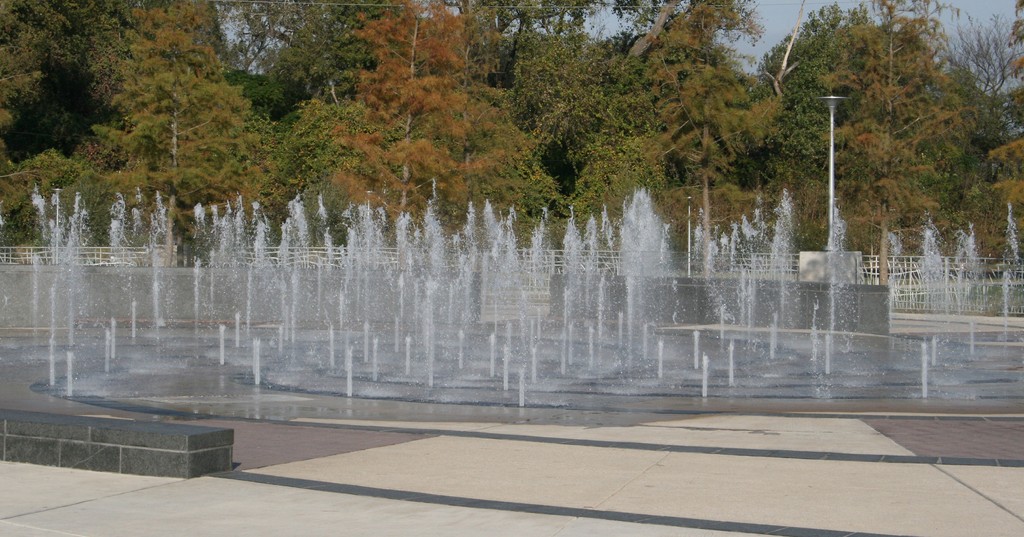The Artful Dance

Advances in fountain technology have defined a new class of animated watershapes that is not only more sophisticated but is also becoming more readily available. Here, Simon Gardiner of Crystal Fountains shares a pair of projects to illustrate how just two of these technologies – that is, submersible LED lighting and systems that make water dance – are helping his company and others bring fresh excitement to watershapes worldwide.
The international fountain business is an exciting, highly competitive and ever-challenging field, basically because the clients are as distinctive as the projects they commission, the settings they provide and the countries they represent. At Crystal Fountains (Toronto), we’ve staked our reputation in the global marketplace on understanding those distinctions and built our competitive edge on keeping up with technological developments that help us animate spaces with water.
The reason this constant forward progress in technology is so critical is that there’s a persistent, ongoing demand for increasingly innovative and spectacular watershapes and displays. Clients everywhere are after the “wow” factor, and no matter where we work – Dubai, Europe or North America – a request for the sensational is the truest common denominator.
Leaping water jets and plumes and lighting effects have been in designers’ repertoires for a long time, of course, but the display possibilities that inspired delight ten years ago are passé today. What’s needed now, in our observation, is technology that sequences the height and timing and intensity of the water and lighting effects – the new keys to piquing curiosity and dazzling the eye.
THE NEW STANDARD
Not long ago, you could set up a standing water feature with 12 nozzles that generated static plumes – and everyone was thrilled. Today, by contrast, these arrays are more likely to feature a dozen nozzles that create myriad water patterns. To that end, part of our ongoing design-development process is dedicated to finding new and different configurations, layouts, height variations and water volumes that will help us produce even broader ranges of visual and aural effects.
In addition, we’ve also chosen to focus our attention on programmable lighting systems and effects and have particularly adopted light-emitting diodes (LEDs) because of the access they give us to a virtually unlimited range of colors and instantaneous color changing.
The combination of these two technologies has enabled our firm (and many others) to achieve extremely specialized effects more readily than in times past. To illustrate these points, let’s visit two projects – one in Poland, the other in Texas – that exemplify the sort of effects that can be achieved.
I: Golden Terraces
In 2004, we were brought in to work with EDAW, the giant international landscape architecture firm, to design and develop watershapes for Zlote Tarasy (that is, Golden Terraces), an upscale shopping complex in Warsaw.
Completed in February 2007, Zlote Tarasy features cascades that cover two plazas – an indoor space with fountains and an outdoor area surrounded by restaurants. We at Crystal Fountains provided components and technical support on several of these watershapes, but by far the most impressive (and relevant in the context of this article) is the 65-foot-long, 13-foot-high, curving water wall that stands at the entrance to the new shopping center.
| The light effects we’re now able to achieve using submersible LEDs has reached a point where the technology can be used to achieve wonderful aesthetic possibilities. Millions of colors are instantly available, meaning we can wash the wall in single colors or in rainbows of shifting colors – and the best of it is that the light is so intense that the colors are remarkably consistent all the way to the top of the wall. |
This watershape is a stand-alone feature designed as the grand entrance to the mall. It’s located in a recessed plaza where it is surrounded by cafes and bars – but more important, it’s also adjacent to the main square as well as the local transit depot, so passengers walk past the feature on their way to and from the station.
The design for the wall and the pool includes a small recessed trough at the foot of the wall in which we installed 27 submersible LED light fixtures. Positioning each one was critical to ensuring maximum color saturation, consistent color washing across the wall and proper intensity to the wall’s full height. With some effort, we figured out that we had to place the LEDs about two inches below the water surface at 31-inch intervals and at points a bit more than 17-1/2 inches from the wall.
To maximize the effect of the LED light show, we had to deal with ambient light as a major issue as well: All other light sources in the area surrounding the water wall had to be controlled and made dimmable during night displays to allow for proper color rendition across the water wall with the greatest possible visual impact.
Once each hour, a 12-minute light show flashes across the water wall. It’s a fast, exciting display featuring rapid changes in colors that bounce across in one direction and then bounce back the other way in another color – or change in myriad other ways. Once that show ends, the display becomes more placid, using color-washing techniques to shift, for example, from blues to greens.
The significance of this project from our perspective is that this was the first time we’d ever used submersible LED lights. We quickly discovered that there was almost no limit to the variety we could achieve and that, indeed, the only real boundaries were budgetary: Developing these effects takes time and money, but beyond that, the sky truly is the limit.
In this case, we provided the clients with video footage of achievable lighting effects. Predictably, that demonstration proved a bit overwhelming, and things really only came together when we were on site and showed the clients basic displays that helped them define their likes and dislikes. It was a key collaborative step: The clients truly took ownership of the system we finally implemented.
The great advantage of programmability is that we can change displays at any time the clients so desires. We develop these new looks in our offices and can simply upload them to the control system via modem: All the client has to do is to review the show on screen and approve it.
II: Animating a Square
We recently participated in a project in The Woodlands, Texas, at Waterway Square. Set in a one-acre public plaza and park, the unique watershapes take advantage of the site’s terraced topography and are surrounded by the planned community’s commercial district – office buildings, shops, restaurants and entertainment venues – as well as green space and some residences.
Waterway Square was commissioned by The Woodlands Development Co., The Woodlands Township and The Woodlands Town Center Owners Association. The space was designed by Watertown, Mass.-based Sasaki Associates, which also designed the 2008 Olympic Green in Beijing among other noteworthy projects.
| The degree of animation we’re now able to achieve with many types of jets brings new excitement to fountains and interactive displays of all shapes and sizes. In this case, there’s a large display fountain that can be programmed in endless combinations of spray heights and volumes as well as a nearby play feature in which children will never have much of a chance to be bored by repetition. |
The watershapes were designed by Aquatic Design Engineering (Oakland, Fla.) and have a number of key and sometimes unique features. We worked closely with them on fountain choreography and also provided them with various jet types and a total of 260 submersible LED lights.
From the surrounding buildings and from the air, the water wall and fountain look like a gigantic musical eighth note. The wall, which is 120 feet long and 10 feet high, is flanked by stairs and water cascades that step down over seven terraced levels and a stone wall to the lower pond. There are a total of 22 cascade jets in all – 20 in the lower pond and two at the top near the upper fountain.
The water jets, waterfalls and cascades create a variety of displays and effects ranging from the subtle flow of water over the stone wall to dancing columns of water – or the setting can erupt with “boomer” jets that shoot water up to 75 feet in the air. The upper area of the park also has multiple sequenced jets choreographed on a rotating basis to eight songs currently in its repertoire. There are 80 controlled jets in the upper area, arranged in three concentric rings.
The interactive deck-level fountain features a mosaic called “Treasures from Grandma’s Purse” and has a total of 34 jets (including six laminar jets) enhanced with colored lights. These jets and the colored lights are choreographed to music heard via 20 speakers and a 4,250-watt sound system driven by five amplifiers.
The entire system is run from a 3,251-square-foot equipment room – located on site, but barely visible. More than two miles of pipe move water from this space to various spots in the watershape complex.
Simon Gardiner is director of creative design for Crystal Fountains, the international waterfeature specialists based in Toronto. An industrial design graduate of the Ontario College of Art & Design, he has more than 17 years’ experience in the watershape design and project management. He is also the author of “Design Considerations of Water Features,” an accredited online course offered by AECDaily.com, an online learning center. Since joining Crystal Fountains in 1998, Gardiner has been involved in some of the company’s most challenging projects in North America and beyond.






















